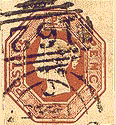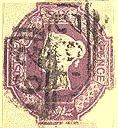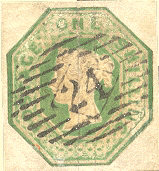|
|
 |
Introduction
The embossed issues were a failed experiment. The introduction of the Uniform Penny Postal System had proven to be a great success and grew rapidly. The line-engraved postage stamps were not produced quickly or economically enough to keep up with the demand. The surface printed postage stamps produced by De la Rue were to be the ultimate solution to the problem. The embossed issues form a curious experiment that fell to the wayside as postal authorities searched for the best way to manufacture postage stamps.
Perhaps the most curious aspect of these stamps
is that they were impressed into the paper by hand one stamp at a time.
A crude and laborious method which seems out of place with the technological
advances being heralded during the Victorian Period. The design of
the embossed stamps is derived from the Wyon City Medal of 1837,
the same source for the design of the Penny Black. The awkward means
of production insured that many of the impressions overlapped and as a
resulted it is rather difficult to obtain four margin copies.
|
|
 |
Characteristics
| Shades | Green, pale green, deep green |
| Dies | Die W.W.1 (1847)
Die W.W.2 (1854) |
| Threads | 5mm apart (normal);
20mm apart
Variety: thread omitted |
| Paper | Dickinson Silk Thread |
| Watermark | None |
|
|
 |
Characteristics
| Shades | Brown, deep brown |
| Dies | W.W.1
(1848)
Die 2 W.W. (1850) Die 3 W.W. (1853) Die 4 W.W. (1854) Die 5 W.W. |
| Threads | 5mm apart (normal);
20mm apart
Variety: one thread |
| Paper | Dickinson Silk Thread |
| Watermark | None |
|
|
 |
Characteristics
| Shades | Mauve, dull lilac, purple, violet |
| Die | Only one die was used |
| Threads | None (normal) |
| Paper | Variety: On thick cartridge paper with silk threads |
| Watermark | VR upright, inverted, inverted reversed |
| Gum | Variety: green gum |
Watermark Varieties
 |
 |
 |
|
|
|
|
Forgeries
 |
The above three stamps consist of cut to shape
copies shaved very thin and laid on top of a paper similar in appearance
and color. The cancellations have been extended with india ink onto
the "margins" very carefully to match the genuine cancellations on the
cut to shape portion of the stamps. The threads have been simulated
with incisions on the back of each stamp. The only easy way to detect
the fraud is by submerging the stamps in watermark fluid, which causes
the cut to shape portion of the stamp to become visible.